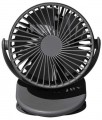Power source
The presence of an autonomous way to power the device. Applicable for portable mini-fans, since stationary
ones are powered by 230 V mains. There are two ways to feed:
-
USB port. Models designed to be installed near the PC workplace. And it's not a problem to find a USB port, both in a PC, a laptop or a power bank.
-
Battery. Portable models that do not need a power supply and can be used even outdoors. The built-in battery allows them to work for a long time. Naturally, the power of such fans is small and, like any battery technology, they need to be recharged and can be discharged at the most unsuitable moment.
Number of speeds
The number of preset speeds at which the fan blades can rotate. The rotation speed is usually set by pressing the corresponding button (in addition, there is also a stepless adjustment, see the relevant paragraph). Most modern models with step adjustment have three preset speeds.
Maximum noise level
The maximum noise level produced by the fan when operating at the highest speed. For comparison: a noise of 30 dB corresponds to a distinguishable whisper at a distance of 5 m, 40 dB — to human speech, and 50 dB — to the sound background in an office room. The quieter the fan runs, the more comfortable it is to use.
Functions
—
Stepless adjustment. The ability to adjust the rotation speed when a slider is used instead of several buttons. In this case, you can set the speed not step by step, but over a wide range.
— Oscillation. Thanks to
the oscillation, the fan can change the direction of the airflow horizontally, while remaining stationary. The direction can be set manually, and it can also change automatically when the fan constantly changes direction. Fans with small blade diameters usually do not have this capability.
—
3D rotation. Automatic rotation is assumed not only in the horizontal plane but also vertically. The implementation of this function is different: horizontal and vertical movements can be alternated, or the head of the fan can make spherical movements. Fans with 3D rotation are better at mixing air, and when used in conjunction with an air conditioner, better cooling efficiency is achieved.
—
Night mode. Designed to reduce noise levels, fans in this mode reduce the speed to a minimum and periodically turn off the rotation of the blades. Note that in this mode you will have to sacrifice the power of the fan, and in hot weather, this mode may not be relevant.
—
Wind imitation. This mode periodically changes the speed of rotation of the blades, sometimes turning them off a
...ltogether, creating gusts of wind. Different manufacturers call this mode differently: comfort mode, breeze mode, natural, and the like, but they all serve the same purpose.
— Height adjustment. The ability to change the height of the fan manually. Provided, usually, in floor standing models.
— Tilt adjustment. The ability to change the tilt angle of the airflow vertically. In the vast majority of models, it is set manually, but some models can change it automatically. Simple and inexpensive models often lack this capability.
— Timer. A device that automatically turns off the fan after a certain time set by the user. The presence of a timer allows, for example, to turn on the fan at night and go to bed — the device will turn itself off at the right time.
— Remote control. Possibility to control the fan from a distance. Advanced fan models are equipped with remote controls that allow you not only to turn the device on and off but also to adjust the speed and set the timer value.
— Control via smartphone. Fans that support this feature can connect to your home Wi-Fi network and be controlled directly from your phone app. Also, some models can be integrated into smart home systems to perform certain scenarios. There are models in which this function completely replaces the remote control.
— Humidification. Fans with this function are a hybrid of a classic fan and a humidifier. They have a reservoir with water and a device that supplies water vapour to the fan blades, where it is carried around the room by airflow. In general, such a combination is more effective than classic humidifiers, as it provides the evenest distribution of moisture. However, fans with humidification are quite rare.
— Ionization. The presence of a built-in air ionizer. It is believed that air saturated with negatively charged oxygen ions is extremely beneficial for health. Not all fan models (even expensive ones) are equipped with an ionizer. However, it can also be purchased separately.
— Backlight. The presence of built-in lighting sources in the fan (usually LED lamps or LED strip). The backlight can be used as an additional light source or night light, and can also be used in a decorative role to improve the appearance of the fan, making it an attractive element of the interior.
— Clip mount. Such a device allows fixing the fan on the edge of the wall shelf opposite the face, which will not only create a more pleasant air flow but save space on the desktop surface (and even on the shelf where the fan is installed). In addition, such a mount is more reliable than a simple installation on a horizontal surface — overtiping a fan with a clip mount is much more difficult than a fan standing on a desktop or a shelf.
— Display. A small screen designed to display various service information. The display can show data on the operating mode, the set timer, the time until the fan is turned off, etc. The display makes fan control more convenient, but other things being equal, such devices are usually more expensive.
